A Satellite-Based Assessment of Divergent Carbon–Water Trends: Vegetation Greening Coincides with Declining Water Use Efficiency in the Haihe River Basin (2001–2023)
Highlights
- Despite a significant increase in vegetation productivity (greening) in the Haihe River Basin from 2001–2023, the basin-wide Water Use Efficiency (WUE) paradoxically showed a statistically significant decline.
- The decline was primarily driven by climate warming, which increased evapotranspiration (ET) at a proportionally faster rate than gross primary production (GPP), overwhelming the beneficial effects of rising precipitation.
- The current greening trajectory in the Haihe River Basin is hydrologically unsus-tainable, as increasing vegetation is consuming water with decreasing efficiency, undermining long-term water security in an already water-scarce region
- Ecological restoration policies must shift from a singular focus on maximizing vegetation cover (‘greening’) to promoting ‘sustainable and water-wise greening,’ which necessitates assessing the hydro-ecological trade-offs of restoration strategies.
Abstract
1. Introduction
2. Materials and Methods
2.1. Study Area
2.2. Data Sources and Pre-Processing
2.2.1. Vegetation Data
2.2.2. Meteorological Data
2.2.3. Topographic Data
2.2.4. Land Use Data
2.2.5. Data Pre-Processing
2.3. Research Methods
2.3.1. Calculation of Vegetation Carbon and Water Use Efficiencies
2.3.2. Spatiotemporal Trend and Significance Analysis
2.3.3. Trend Persistence Analysis
2.3.4. Attribution of Vegetation Trends Using Multiple Linear Regression
2.3.5. Sensitivity Analysis
3. Results
3.1. Spatiotemporal Patterns and Trends of Vegetation Productivity, Evapotranspiration, and Water–Carbon Use Efficiency
3.1.1. Spatiotemporal Distribution of Vegetation Factors
3.1.2. Spatiotemporal Distribution of Vegetation Carbon and Water Use Efficiencies
3.1.3. Evolution Trend of Vegetation Carbon and Water Use Efficiencies
3.2. Spatiotemporal Patterns and Changes in Climate Factors and Land Use
3.2.1. Spatiotemporal Distribution of Climate Factors
3.2.2. Evolution Trend of Climate Factors
3.2.3. Land Use Change
3.3. Influences of Climate and Land Use Change on Vegetation Water–Carbon Use Efficiency
3.3.1. Partial Correlation Between Vegetation Carbon and Water Use Efficiencies
3.3.2. Partial Correlation Between Climate Factors and Vegetation Carbon and Water Use Efficiencies
3.3.3. Partial Correlation Between Climate Factors and C-W Process Elements (NPP, GPP, ET)
3.3.4. Contribution Values of Climate Factors to Vegetation Carbon and Water Use Efficiencies
3.3.5. Relative Contribution Rates of Climate Factors to Vegetation Carbon and Water Use Efficiencies
4. Discussion
4.1. The Decoupling of Greening and Water Use Efficiency: Increased Productivity Does Not Guarantee Improved Water Use Efficiency
4.2. Divergent Biophysical Controls on Carbon Allocation (CUE) and Water–Carbon Coupling (WUE)
4.3. Attribution of Trends: The Competing Roles of Water Supply, Atmospheric Demand, and Land Use
4.4. Uncertainties, Limitations, and Future Directions
4.5. Broader Implications for Sustainable Management
5. Conclusions
Author Contributions
Funding
Data Availability Statement
Conflicts of Interest
Appendix A
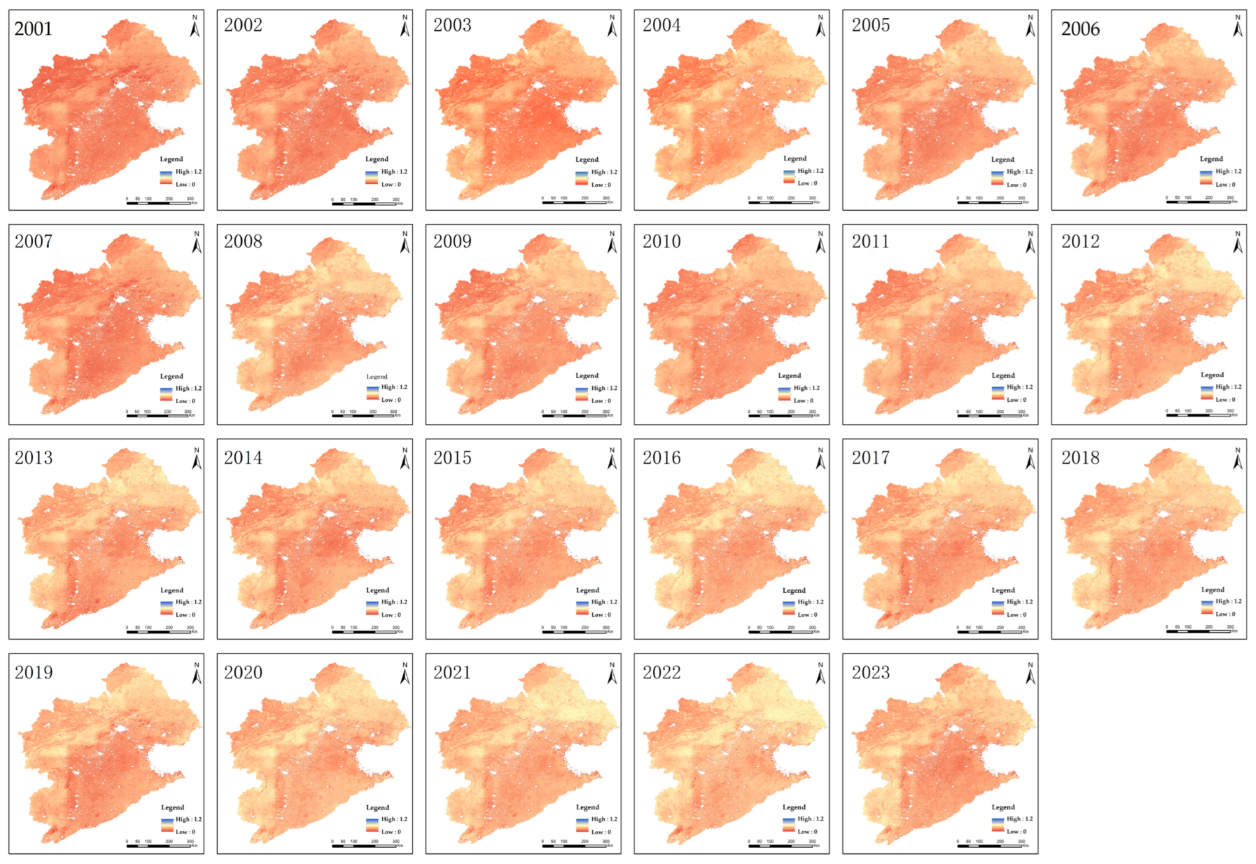
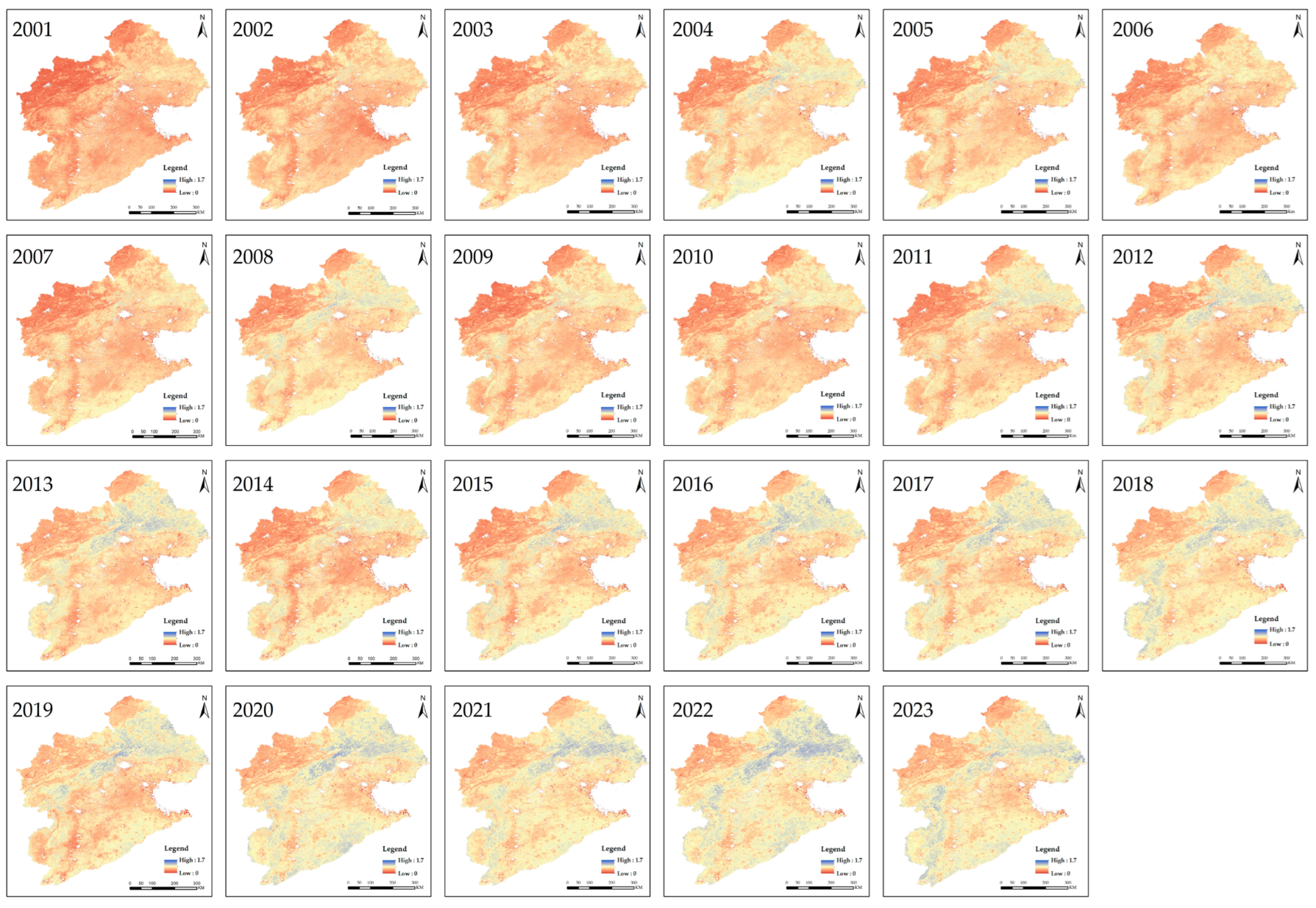
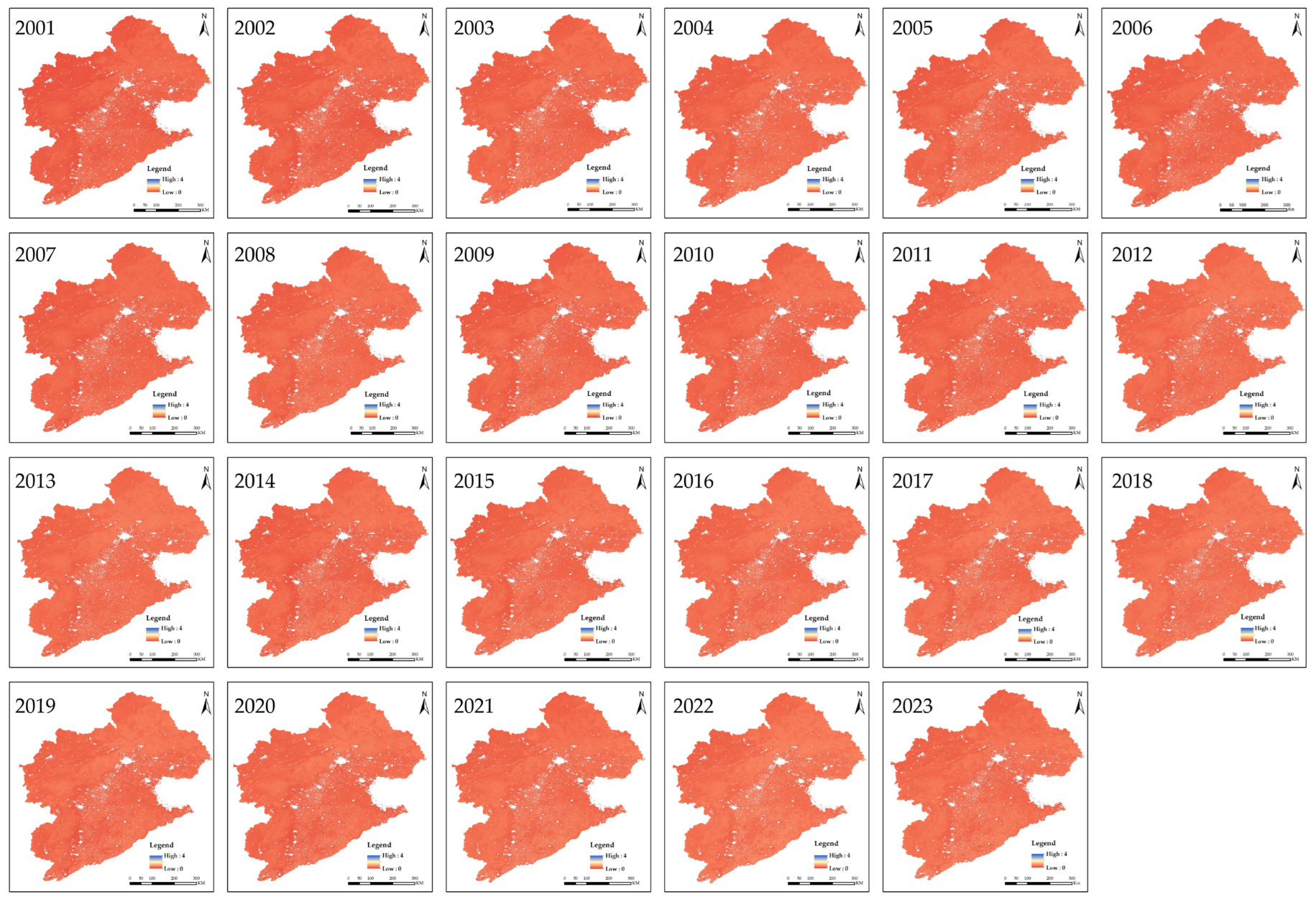

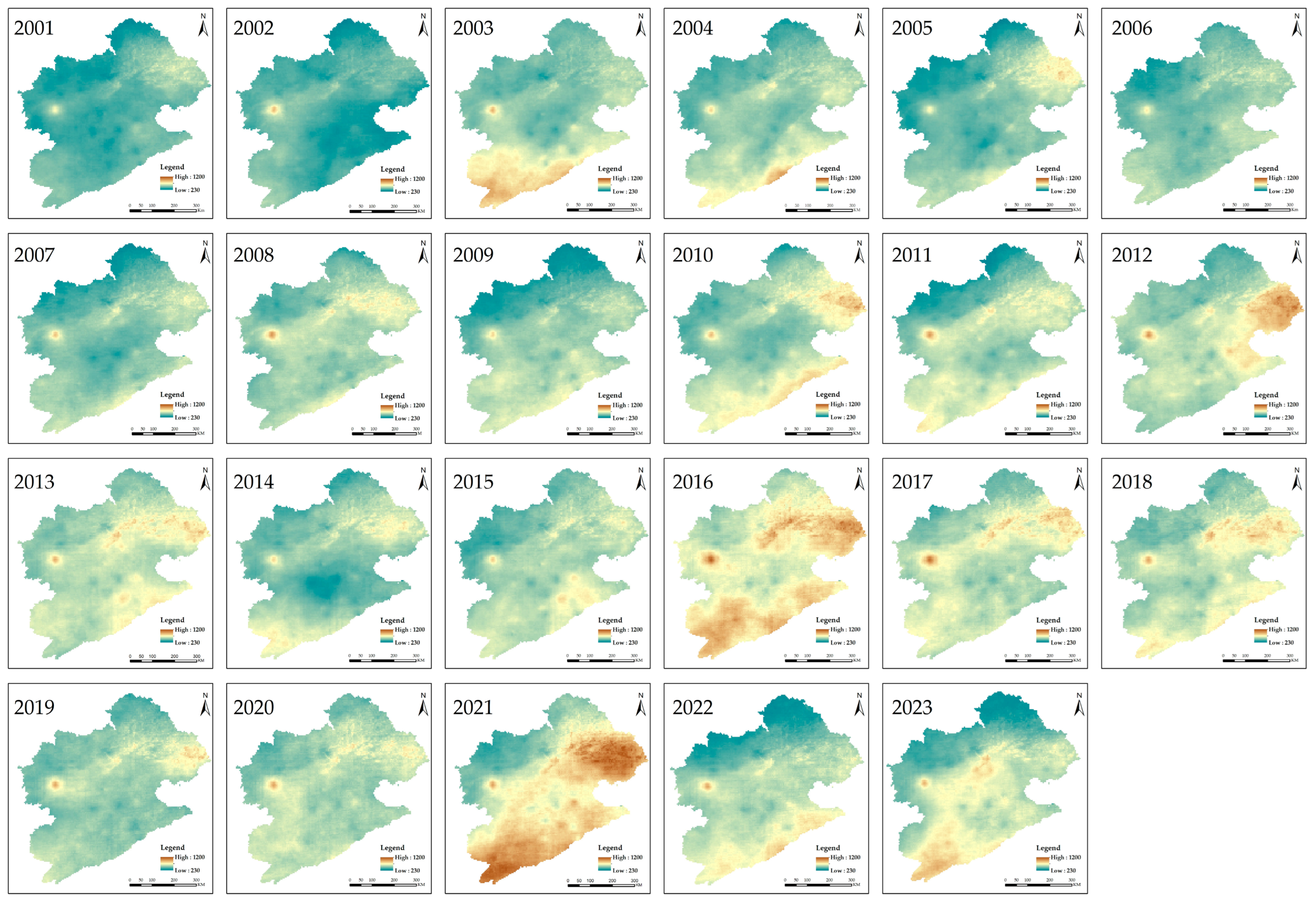






References
- IPCC. Summary for Policymakers. In Climate Change 2021: The Physical Science Basis. Contribution of Working Group I to the Sixth Assessment Report of the Intergovernmental Panel on Climate Change; Masson-Delmotte, V., Zhai, P., Pirani, A., Connors, S.L., Péan, C., Berger, S., Caud, N., Chen, Y., Eds.; Cambridge University Press: Cambridge, UK, 2021; pp. 3–32. [Google Scholar]
- Seneviratne, S.I.; Zhang, X.; Adnan, M.; Badi, W.; Dereczynski, C.; Di Luca, A.; Ghosh, S.; Iskandar, I.; Kossin, J.; Lewis, S.; et al. Weather and Climate Extreme Events in a Changing Climate. In Climate Change 2021: The Physical Science Basis. Contribution of Working Group I to the Sixth Assessment Report of the Intergovernmental Panel on Climate Change; Cambridge University Press: Cambridge, UK, 2021; pp. 1513–1766. [Google Scholar]
- Bonan, G.B. Forests and climate change: Forcings, feedbacks, and the climate benefits of forests. Science 2008, 320, 1444–1449. [Google Scholar] [CrossRef]
- Reichstein, M.; Bahn, M.; Ciais, P.; Frank, D.; Mahecha, M.D.; Seneviratne, S.I.; Zscheischler, J.; Beer, C.; Buchmann, N.; Frank, D.C.; et al. Climate extremes and the carbon cycle. Nature 2013, 500, 287–295. [Google Scholar] [CrossRef] [PubMed]
- Waring, R.H.; Landsberg, J.J.; Williams, M. Net primary production of forests: A constant fraction of gross primary production? Tree Physiol. 1998, 18, 129–134. [Google Scholar] [CrossRef]
- DeLucia, E.H.; Drake, J.E.; Thomas, R.B.; Gonzalez-Meler, M. Forest carbon use efficiency: Is respiration a constant fraction of gross primary production? Glob. Change Biol. 2007, 13, 1157–1167. [Google Scholar] [CrossRef]
- Tang, X.; Li, H.; Desai, A.R.; Vargas, R.; Göckede, M.; Chen, J.; Schwalm, C.R.; Baldocchi, D. How is water use efficiency of terrestrial ecosystems distributed and changing on Earth? Sci. Rep. 2014, 4, 7483. [Google Scholar] [CrossRef] [PubMed]
- Ponce Campos, G.E.; Moran, M.S.; Huete, A.; Zhang, Y.; Bresloff, C.; Huxman, T.E.; Eamus, D.; Bosch, D.D.; Buda, A.R.; Gunter, S.A.; et al. Ecosystem resilience despite large-scale altered hydroclimatic conditions. Nature 2013, 494, 349–352. [Google Scholar] [CrossRef]
- Sun, Y.; Piao, S.; Huang, M.; Ciais, P.; Zeng, Z.; Cheng, L.; Li, X.; Zhang, T.; Mao, J.; Peng, S.; et al. Global patterns and climate drivers of water-use efficiency in terrestrial ecosystems. Glob. Ecol. Biogeogr. 2016, 25, 311–323. [Google Scholar] [CrossRef]
- Huang, M.; Piao, S.; Sun, Y.; Ciais, P.; Cheng, L.; Mao, J.; Poulter, B.; Shi, X.; Zeng, Z.; Wang, Y. Change in terrestrial ecosystem water-use efficiency over the last three decades. Glob. Change Biol. 2015, 21, 2366–2378. [Google Scholar] [CrossRef]
- Zhang, Y.; Yu, G.; Yang, J.; Wimberly, M.C.; Zhang, X.; Tao, J.; Jiang, Y.; Zhu, J. Climate-driven global changes in carbon use efficiency. Glob. Ecol. Biogeogr. 2014, 23, 144–155. [Google Scholar] [CrossRef]
- Piao, S.; Wang, X.; Park, T.; Chen, C.; Lian, X.; Cescatti, A.; Huntingford, C.; Myneni, R.B. Characteristics, drivers and feedbacks of global greening. Nat. Rev. Earth Environ. 2020, 1, 14–27. [Google Scholar] [CrossRef]
- Li, Y.; Piao, S.; Li, L.; Chen, A.; Wang, X.; Ciais, P.; Huang, L.; Lian, X.; Peng, S.; Zeng, Z.; et al. Divergent hydrological response to large-scale afforestation and vegetation greening in China. Sci. Adv. 2018, 4, eaar4182. [Google Scholar] [CrossRef]
- Tang, L.; Chen, X.; Cai, X.; Li, J. Disentangling the roles of land-use-related drivers on vegetation greenness across China. Environ. Res. Lett. 2021, 16, 124033. [Google Scholar] [CrossRef]
- Yang, W.; Zhao, Y.; Wang, Q.; Guan, B. Climate, CO2, and anthropogenic drivers of accelerated vegetation greening in the Haihe River Basin. Remote Sens. 2022, 14, 268. [Google Scholar] [CrossRef]
- Zou, W.; Yin, S.; Wang, W. Spatial interpolation of the extreme hourly precipitation at different return levels in the Haihe River basin. J. Hydrol. 2021, 598, 126273. [Google Scholar] [CrossRef]
- Martinsen, G.; Liu, S.; Mo, X.; Bauer-Gottwein, P. Optimizing water resources allocation in the Haihe River basin under groundwater sustainability constraints. J. Geogr. Sci. 2019, 29, 935–958. [Google Scholar] [CrossRef]
- Kang, J.; Zi, X.; Wang, S.; He, L. Evaluation and optimization of agricultural water resources carrying capacity in Haihe River Basin, China. Water 2019, 11, 999. [Google Scholar] [CrossRef]
- Zhang, Y.; Song, C.; Sun, G.; Band, L.E.; McNulty, S.; Noormets, A.; Zhang, Q.; Zhang, Z. Development of a coupled carbon and water model for estimating global gross primary productivity and evapotranspiration based on eddy flux and remote sensing data. Agric. For. Meteorol. 2016, 223, 116–131. [Google Scholar] [CrossRef]
- Han, L.; Wang, Q.; Chen, Z.; Yu, G.; Zhou, G.; Chen, S.; Li, Y.-N.; Zhang, Y.-P.; Yan, J.-H.; Wang, M.; et al. Spatial patterns and climate controls of seasonal variations in carbon fluxes in China’s terrestrial ecosystems. Glob. Planet. Change 2020, 189, 103175. [Google Scholar] [CrossRef]
- Zhu, Z.; Piao, S.; Myneni, R.B.; Huang, M.; Zeng, Z.; Canadell, J.G.; Ciais, P.; Sitch, S.; Friedlingstein, P.; Arneth, A.; et al. Greening of the Earth and its drivers. Nat. Clim. Change 2016, 6, 791–795. [Google Scholar] [CrossRef]
- Ge, J.; Zou, C. Impacts of woody plant encroachment on regional climate in the southern Great Plains of the United States. J. Geophys. Res. D 2013, 118, 9093–9104. [Google Scholar] [CrossRef]
- Cheng, L.; Zhang, L.; Wang, Y.; Canadell, J.G.; Chiew, F.H.; Beringer, J.; Li, L.; Miralles, D.G.; Piao, S.; Zhang, Y. Recent increases in terrestrial carbon uptake at little cost to the water cycle. Nat. Commun. 2017, 8, 110. [Google Scholar] [CrossRef]
- Zhou, S.; Williams, A.P.; Berg, A.M.; Cook, B.I.; Zhang, Y.; Hagemann, S.; Lorenz, R.; Seneviratne, S.; Gentine, P. Land–atmosphere feedbacks exacerbate concurrent soil drought and atmospheric aridity. Proc. Natl. Acad. Sci. USA 2019, 116, 18848–18853. [Google Scholar] [CrossRef]
- Keenan, T.F.; Prentice, I.C.; Canadell, J.G.; Williams, C.A.; Wang, H.; Raupach, M.; Collatz, G.J. Recent pause in the growth rate of atmospheric CO2 due to enhanced terrestrial carbon uptake. Nat. Commun. 2016, 7, 13428. [Google Scholar] [CrossRef]
- Sun, S.; Chen, B.; Yan, J.; Van Zwieten, L.; Wang, H.; Dong, J.; Fu, P.; Song, Z. Potential impacts of land use and land cover change (LUCC) and climate change on evapotranspiration and gross primary productivity in the Haihe River Basin, China. J. Clean. Prod. 2024, 476, 143729. [Google Scholar] [CrossRef]
- Lei, H.; Yang, D.; Huang, M. Impacts of climate change and vegetation dynamics on runoff in the mountainous region of the Haihe River basin in the past five decades. J. Hydrol. 2014, 511, 786–799. [Google Scholar] [CrossRef]
- Sun, Y.; Shan, M.; Pei, X.; Zhang, X.; Yang, Y. Assessment of the impacts of climate change and human activities on vegetation cover change in the Haihe River basin, China. Phys. Chem. Earth 2020, 115, 102834. [Google Scholar] [CrossRef]
- Liu, L.; Lei, Y.; Zhuang, M.; Ding, S. The impact of climate change on urban resilience in the Beijing-Tianjin-Hebei region. Sci. Total Environ. 2022, 827, 154157. [Google Scholar] [CrossRef] [PubMed]
- Zou, Y.; Chen, W.; Li, S.; Wang, T.; Yu, L.; Xu, M.; Singh, R.P.; Liu, C. Spatio-Temporal changes in vegetation in the last two decades (2001–2020) in the Beijing–Tianjin–Hebei region. Remote Sens. 2022, 14, 3958. [Google Scholar] [CrossRef]
- Li, X.; Xu, W.; Song, S.; Sun, J. Sources and spatiotemporal distribution characteristics of nitrogen and phosphorus loads in the Haihe River Basin, China. Mar. Pollut. Bull. 2023, 189, 114756. [Google Scholar] [CrossRef]
- Yang, J.; Huang, X. 30 m annual land cover dataset and its dynamics in China from 1990 to 2019. Earth Syst. Sci. Data 2021, 13, 3907–3925. [Google Scholar] [CrossRef]
- Running, S.W.; Zhao, M. Daily GPP and annual NPP (MOD17A2/A3) products NASA Earth Observing System MODIS land algorithm. In MOD17 User’s Guide; NASA: Washington, DC, USA, 2015; pp. 1–28. [Google Scholar]
- Mu, Q.; Zhao, M.; Running, S.W. Improvements to a MODIS global terrestrial evapotranspiration algorithm. Remote Sens. Environ. 2011, 115, 1781–1800. [Google Scholar] [CrossRef]
- Sen, P.K. Estimates of the regression coefficient based on Kendall’s tau. J. Am. Stat. Assoc. 1968, 63, 1379–1389. [Google Scholar] [CrossRef]
- Mann, H.B. Nonparametric Tests Against Trend. Econ. J. Econ. Soc. 1945, 13, 245. [Google Scholar] [CrossRef]
- Kendall, M.G. Rank Correlation Methods; Griffin: London, UK, 1948. [Google Scholar]
- Hurst, H.E. Long-Term Storage Capacity of Reservoirs. Trans. Am. Soc. Civ. Eng. 1951, 116, 770–799. [Google Scholar] [CrossRef]
- Dettinger, M.D.; Cayan, D.R. Large-Scale Atmospheric Forcing of Recent Trends toward Early Snowmelt in California. J. Clim. 1995, 8, 606–623. [Google Scholar] [CrossRef]
- Piao, S.; Yin, G.; Tan, J.; Cheng, L.; Huang, M.; Li, Y.; Liu, R.; Mao, J.; Myneni, R.B.; Peng, S.; et al. Detection and attribution of vegetation greening trend in China over the last 30 years. Glob. Change Biol. 2015, 21, 1601–1609. [Google Scholar] [CrossRef]
- Yuan, W.; Zheng, Y.; Piao, S.; Ciais, P.; Lombardozzi, D.; Wang, Y.; Ryu, Y.; Chen, G.; Dong, W.; Hu, Z.; et al. Increased atmospheric vapor pressure deficit reduces global vegetation growth. Sci. Adv. 2019, 5, eaax1396. [Google Scholar] [CrossRef]
- Novick, K.A.; Ficklin, D.L.; Stoy, P.C.; Williams, C.A.; Bohrer, G.; Oishi, A.C.; Papuga, S.A.; Blanken, P.D.; Noormets, A.; Phillips, R.P.; et al. The increasing importance of atmospheric demand for ecosystem water and carbon cycles. Nat. Clim. Change 2016, 6, 1023–1027. [Google Scholar] [CrossRef]
- Murray, B.C. Trading water for carbon with biological sequestration. Science 2005, 310, 1944–1947. [Google Scholar] [CrossRef] [PubMed]
- Xu, H.; Xiao, J.; Zhang, Z.; Ollinger, S.V.; Hollinger, D.Y.; Pan, Y.; Wan, J. Canopy photosynthetic capacity drives contrasting age dynamics of resource use efficiencies between mature temperate evergreen and deciduous forests. Glob. Change Biol. 2020, 26, 6156–6167. [Google Scholar] [CrossRef] [PubMed]
- Heskel, M.A.; O’Sullivan, O.S.; Reich, P.B.; Tjoelker, M.G.; Weerasinghe, L.K.; Penillard, A.; Egerton, J.J.G.; Creek, D.; Bloomfield, K.J.; Xiang, J.; et al. Convergence in the temperature response of leaf respiration across biomes and plant functional types. Proc. Natl. Acad. Sci. USA 2016, 113, 3832–3837. [Google Scholar] [CrossRef] [PubMed]
- Fisher, P.F. The pixel: A snare and a delusion. Int. J. Remote Sens. 1997, 18, 679–685. [Google Scholar] [CrossRef]
- Frank, D.C.; Poulter, B.; Saurer, M.; Esper, J.; Huntingford, C.; Helle, G.; Treydte, K.; Zimmermann, N.E.; Leuenberger, M.C.; Verstege, A.; et al. Water-use efficiency and transpiration across European forests during the Anthropocene. Nat. Clim. Change 2015, 5, 579–583. [Google Scholar] [CrossRef]
- Ainsworth, E.A.; Long, S.P. What have we learned from 15 years of free-air CO2 enrichment (FACE)? A meta-analytic review of the responses of photosynthesis, canopy properties and plant production to rising CO2. New Phytol. 2005, 165, 351–372. [Google Scholar] [CrossRef]
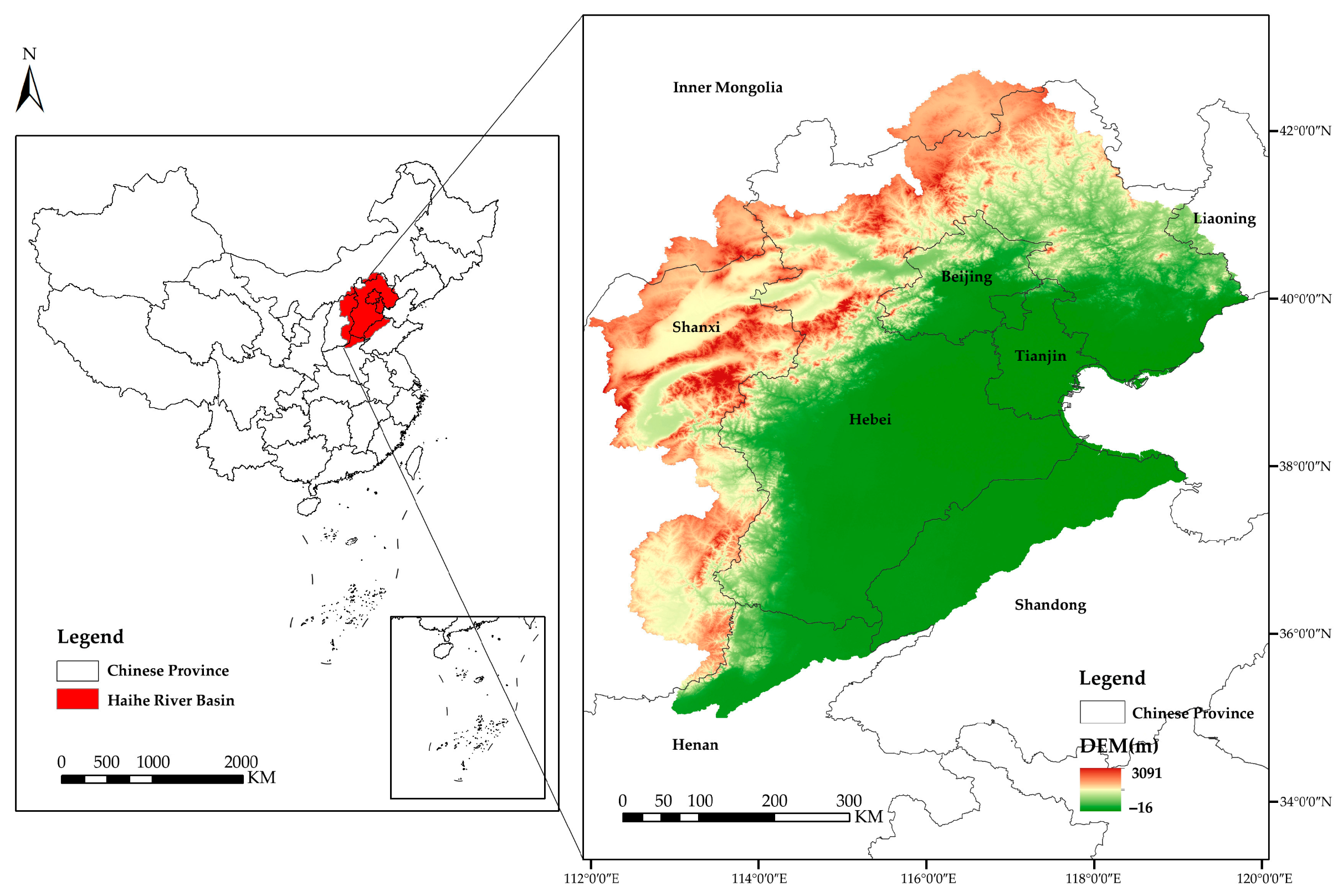

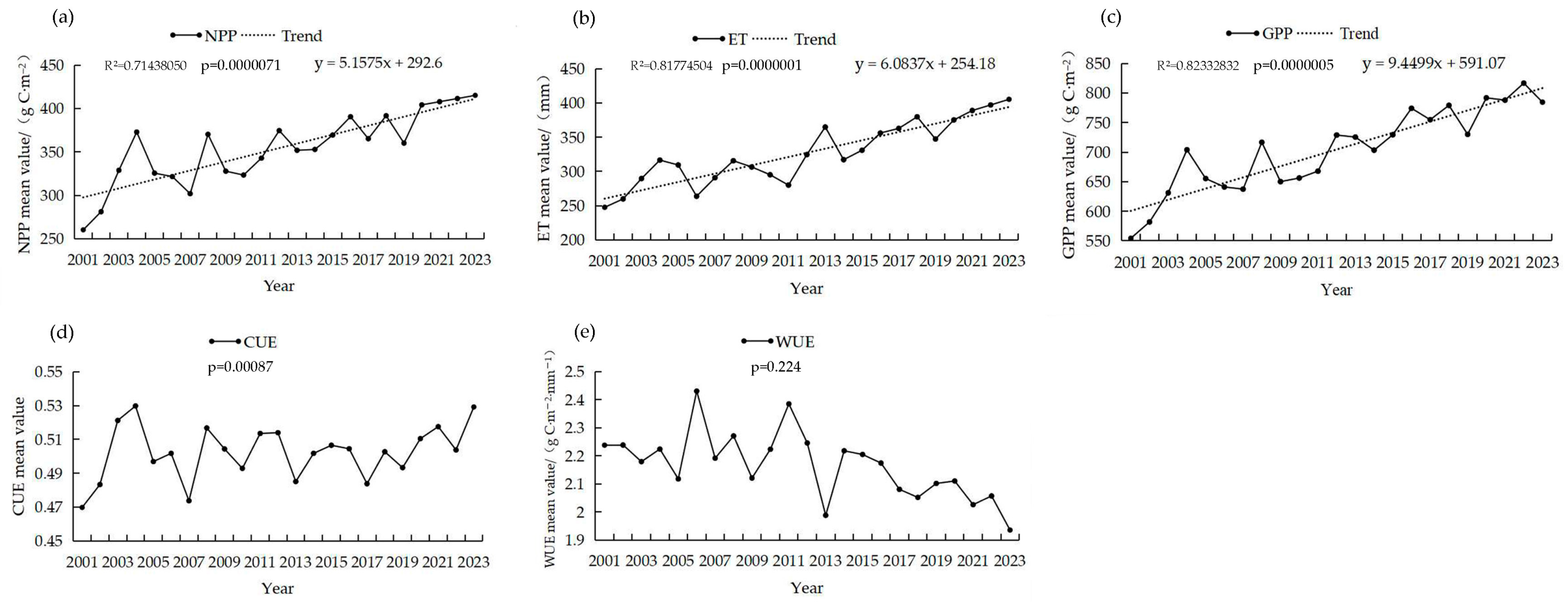

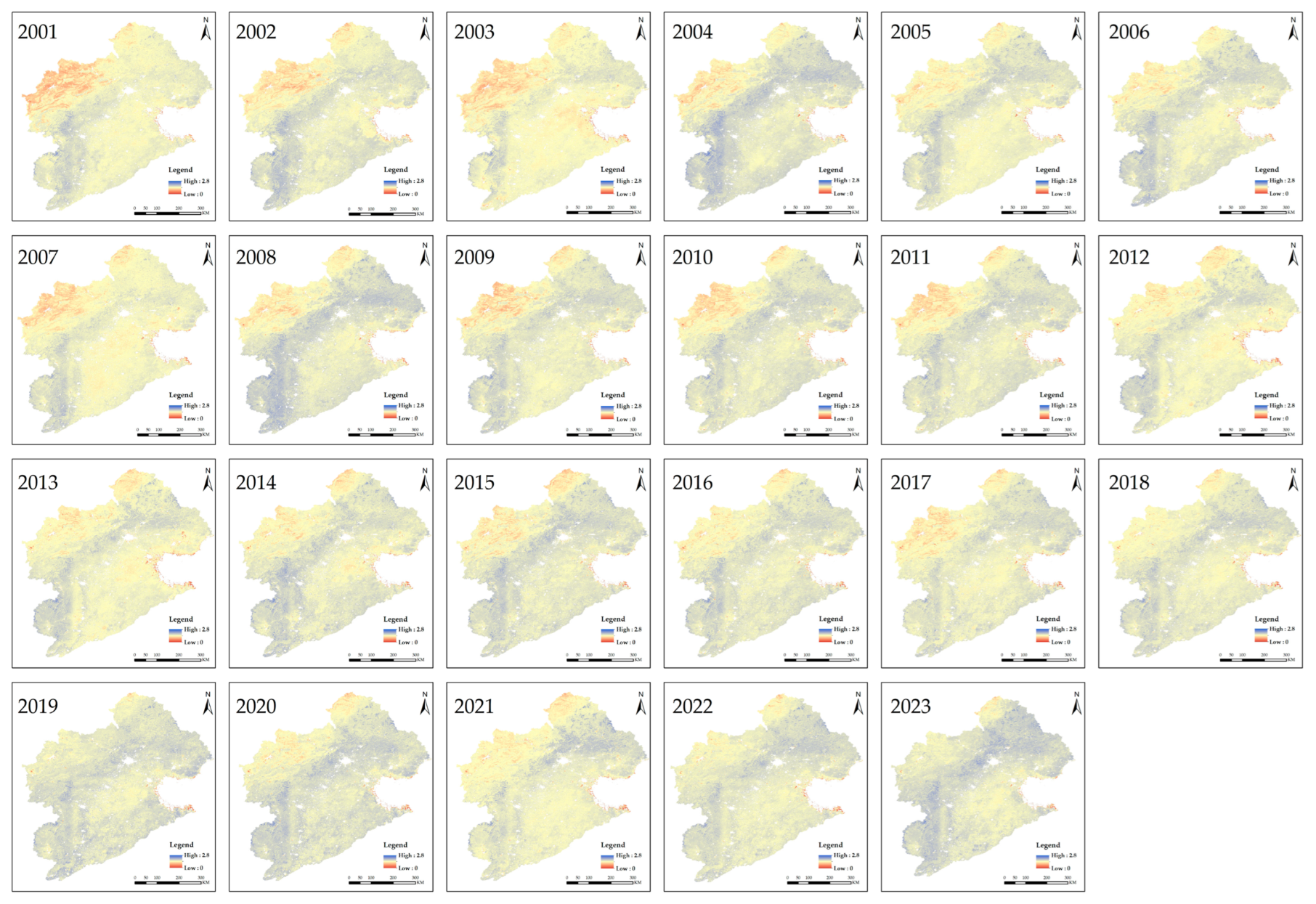
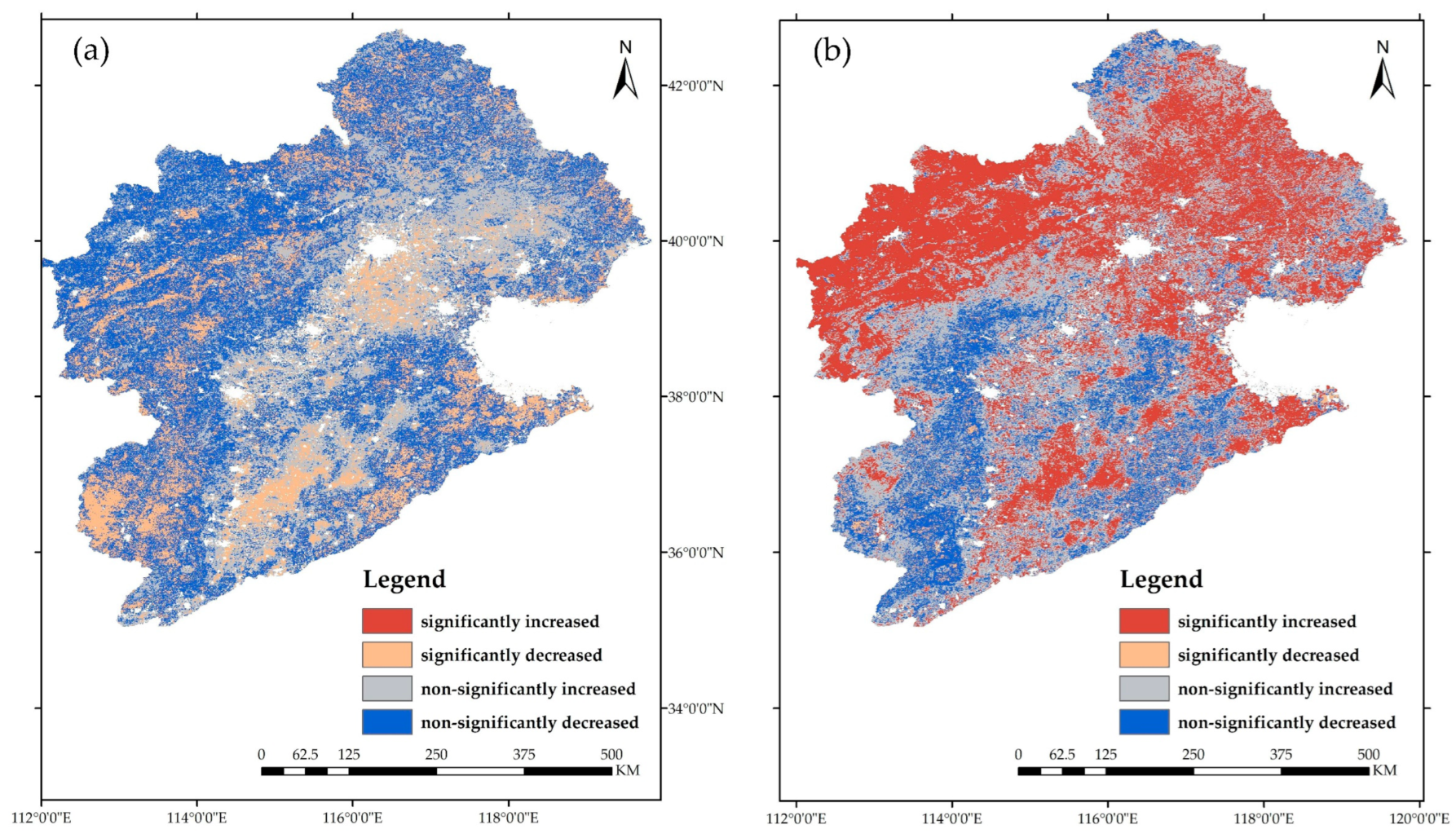
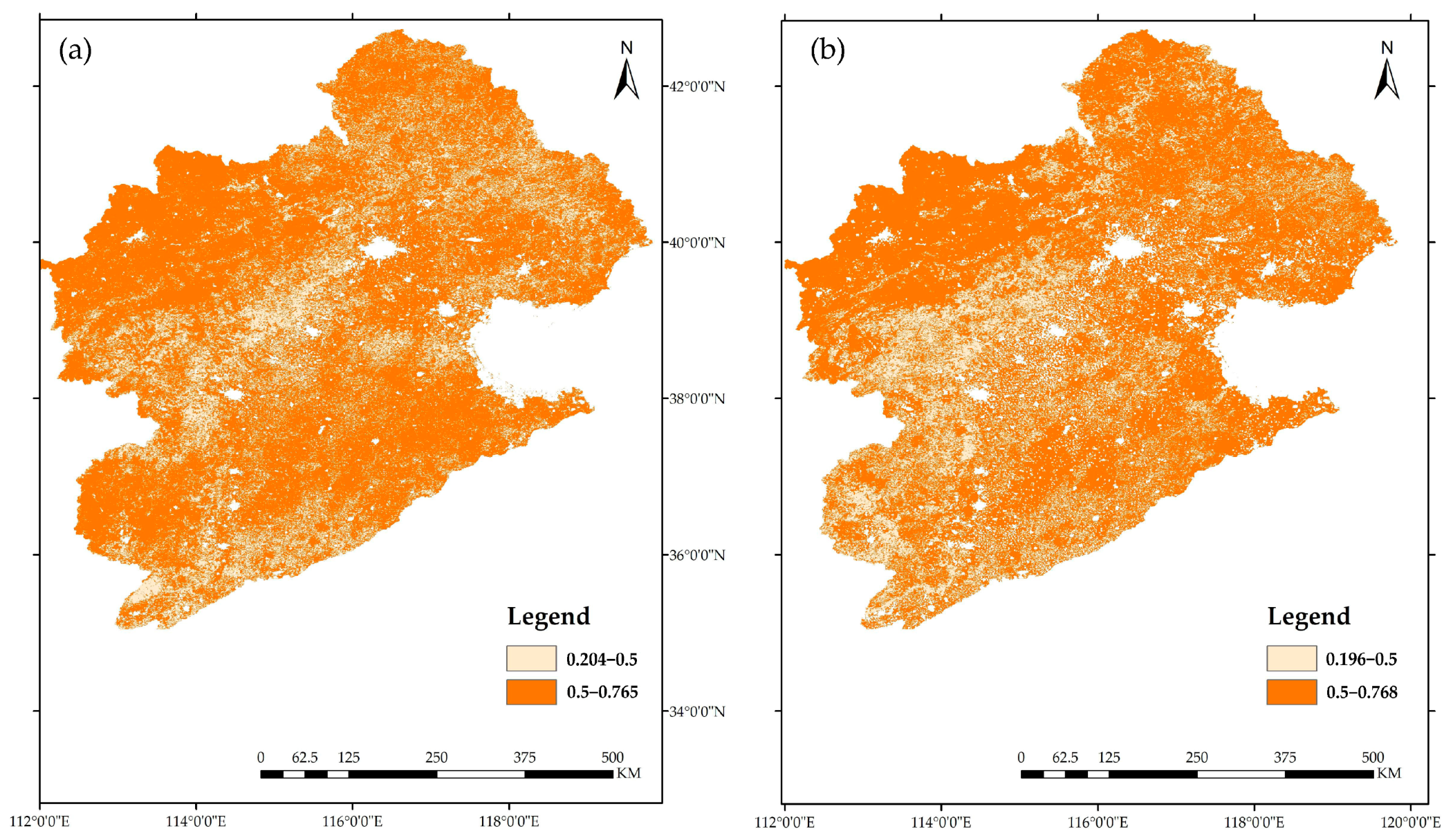
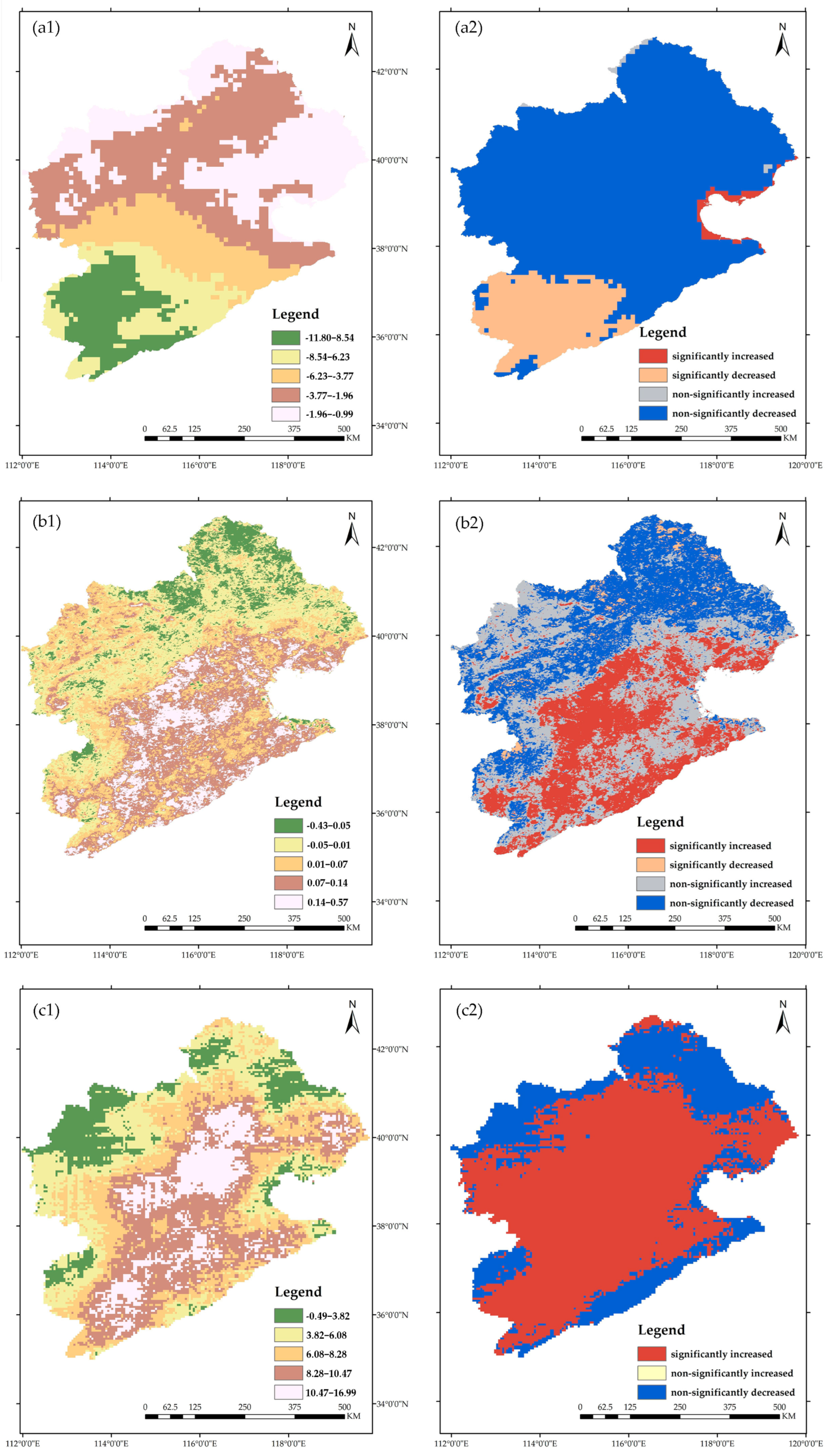
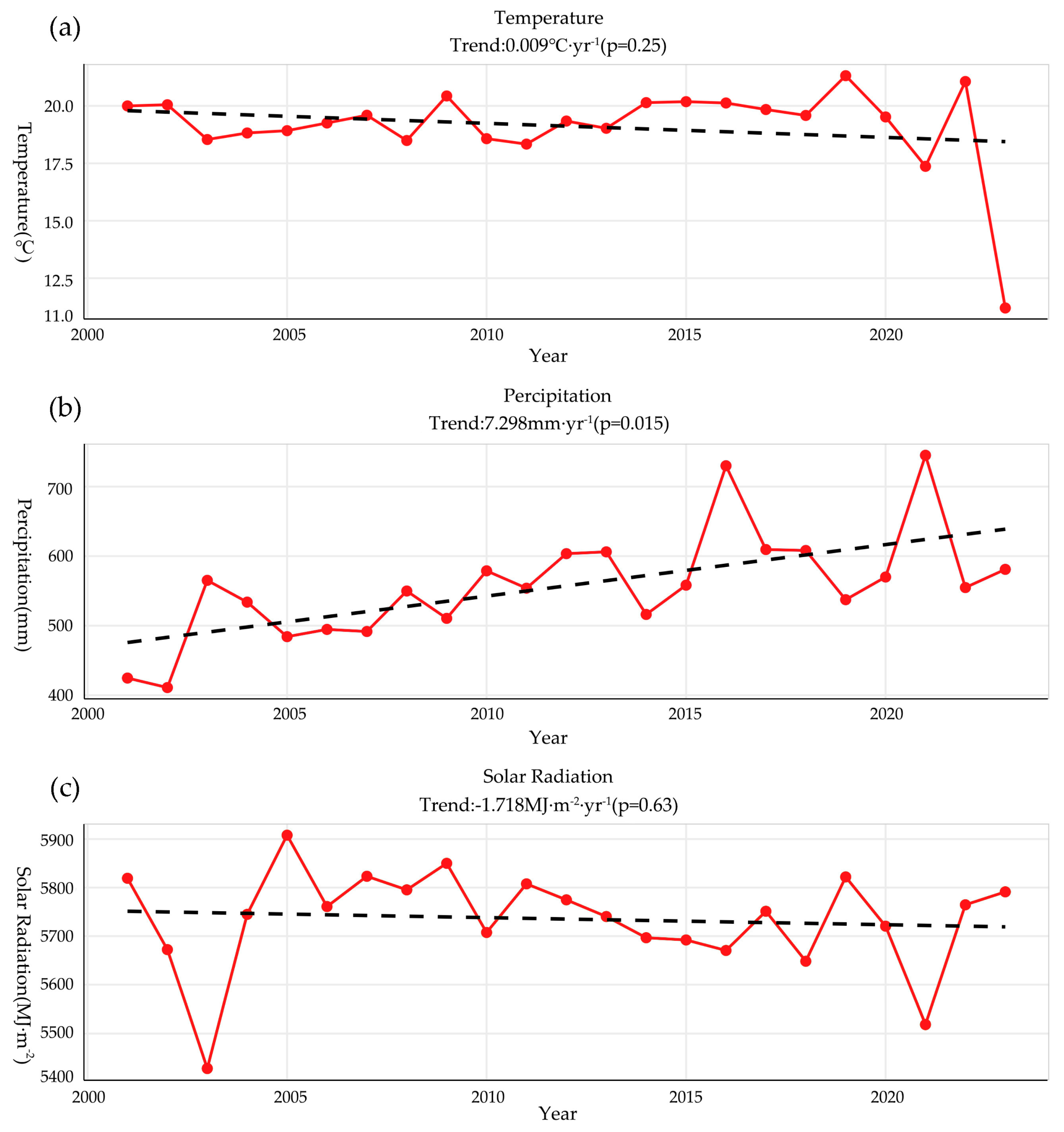
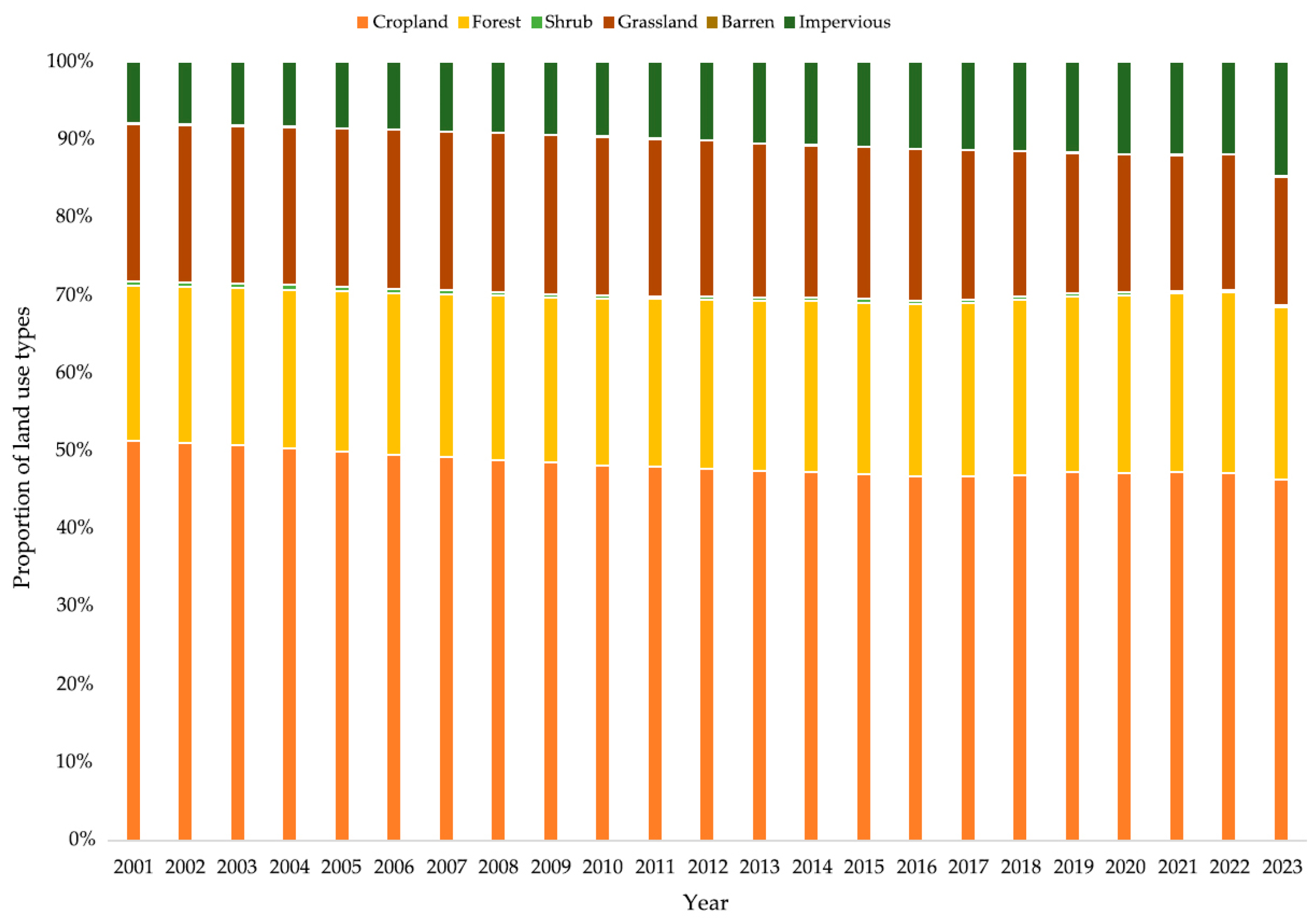
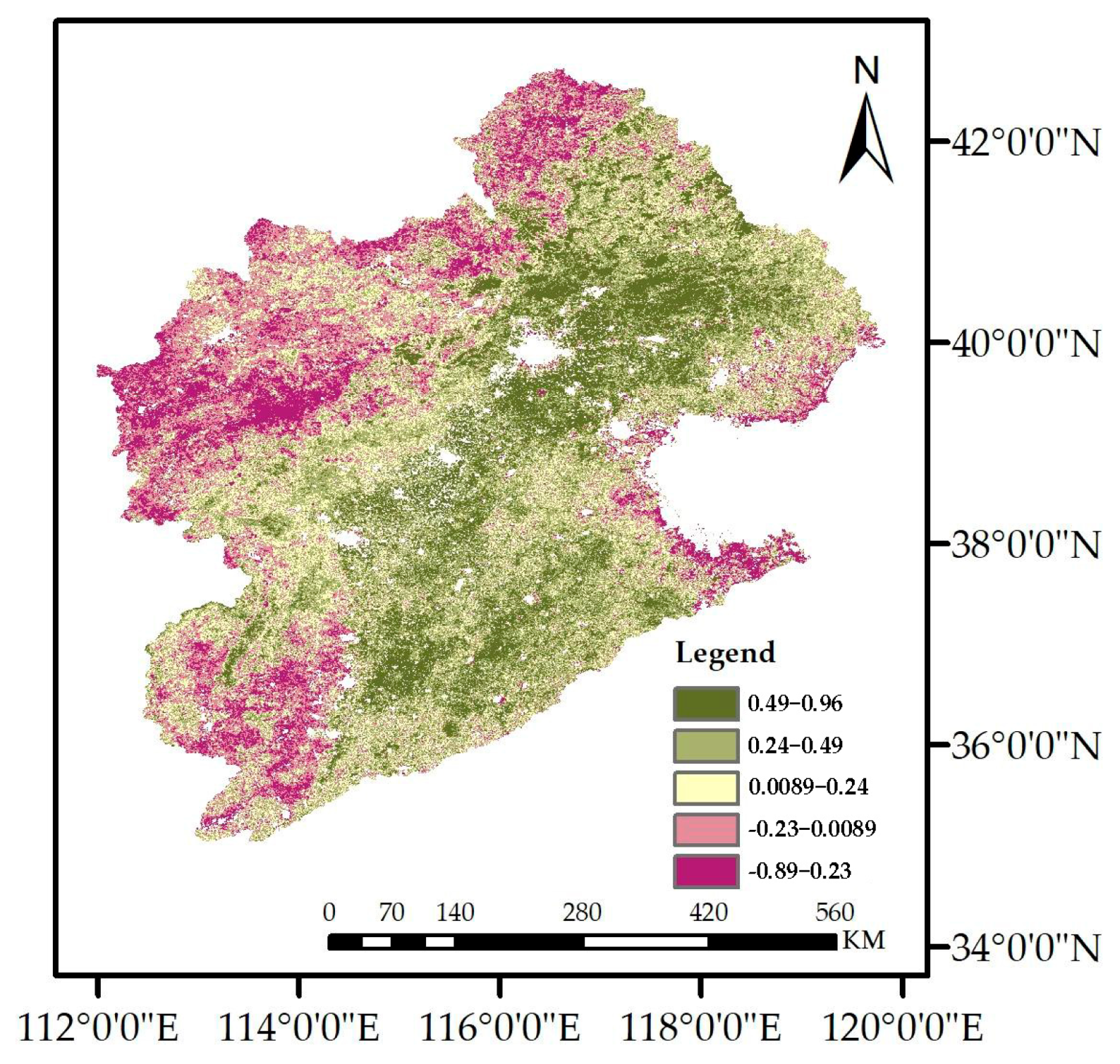


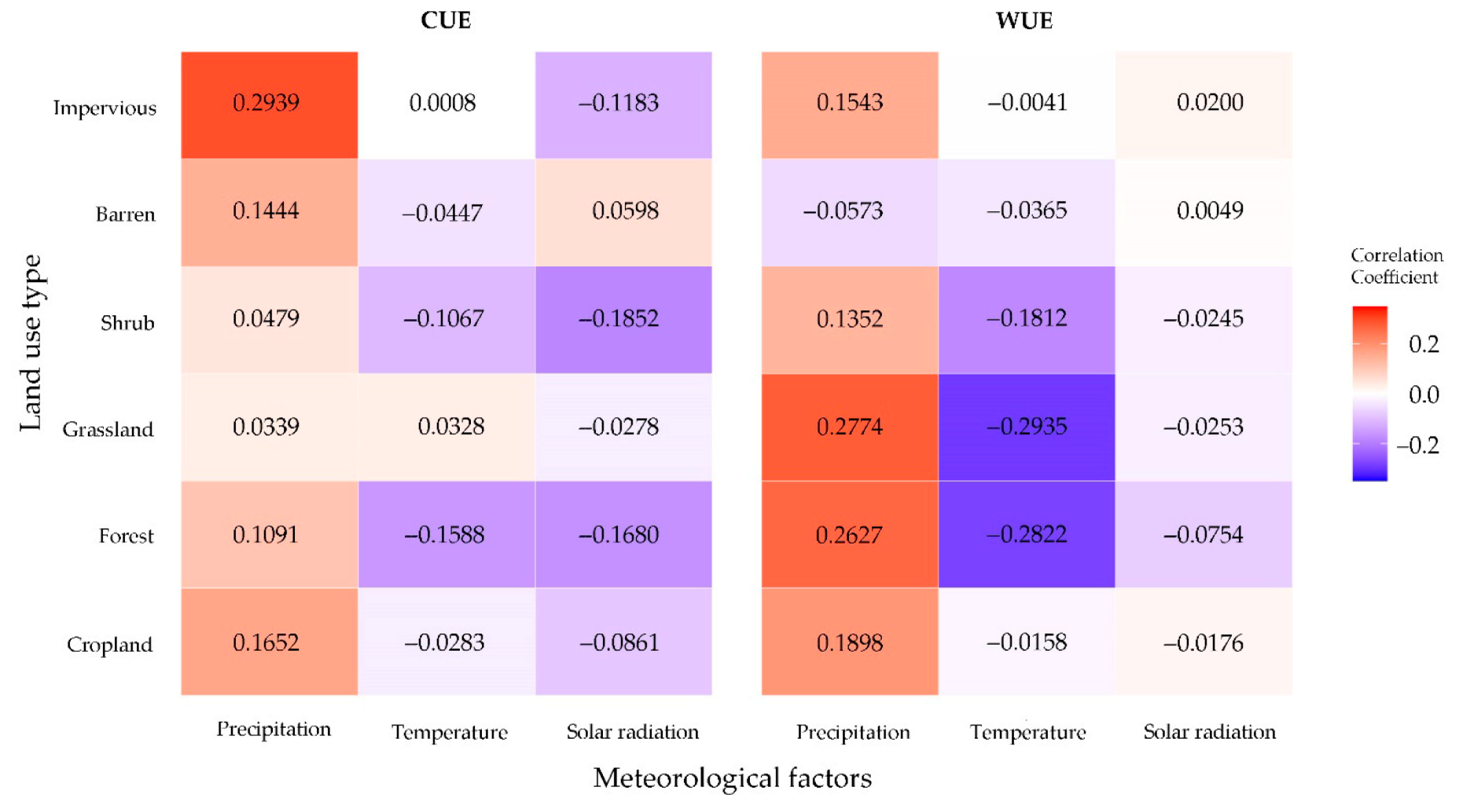


| Data Name | Specific Data (Unit) | Product Name | Spatial Resolution | Temporal Resolution | Source |
|---|---|---|---|---|---|
| Vegetation Data | GPP (g C·m−2) | MOD17A2HGF (v061) | 500 m | 8-day | NASA LP DAAC 1 |
| NPP (g C·m−2) | MOD17A2HGF (v061) | 500 m | Annual | NASA LP DAAC 1 | |
| ET (mm) | MOD16A2GF (v061) | 500 m | 8-day | NASA LP DAAC 1 | |
| Meteorological Data | Temperature (°C) | ERA5-Land | 0.1° | Hourly | European Centre for Medium-Range Weather Forecasts (ECMWF) |
| Precipitation (mm) | CHIRPS Daily v2.0 | 0.05° | Daily | UCSB Climate Hazards Center | |
| Solar Radiation (MJ·m−2) | ERA5-Land | 0.1° | Hourly | European Centre for Medium-Range Weather Forecasts (ECMWF) | |
| Topographic Data | DEM (m) | SRTM-1 Arc-Second Global | 30 m | N/A | U.S. Geological Survey (USGS) |
| Land Use Data | Land Use/Land Cover | CLCD | 30 m | Annual | Yang and Huang [32] |
Disclaimer/Publisher’s Note: The statements, opinions and data contained in all publications are solely those of the individual author(s) and contributor(s) and not of MDPI and/or the editor(s). MDPI and/or the editor(s) disclaim responsibility for any injury to people or property resulting from any ideas, methods, instructions or products referred to in the content. |
© 2025 by the authors. Licensee MDPI, Basel, Switzerland. This article is an open access article distributed under the terms and conditions of the Creative Commons Attribution (CC BY) license (https://creativecommons.org/licenses/by/4.0/).
Share and Cite
Xu, F.; Guo, J.; Wang, X. A Satellite-Based Assessment of Divergent Carbon–Water Trends: Vegetation Greening Coincides with Declining Water Use Efficiency in the Haihe River Basin (2001–2023). Remote Sens. 2025, 17, 3505. https://doi.org/10.3390/rs17213505
Xu F, Guo J, Wang X. A Satellite-Based Assessment of Divergent Carbon–Water Trends: Vegetation Greening Coincides with Declining Water Use Efficiency in the Haihe River Basin (2001–2023). Remote Sensing. 2025; 17(21):3505. https://doi.org/10.3390/rs17213505
Chicago/Turabian StyleXu, Fang, Jia Guo, and Xiyue Wang. 2025. "A Satellite-Based Assessment of Divergent Carbon–Water Trends: Vegetation Greening Coincides with Declining Water Use Efficiency in the Haihe River Basin (2001–2023)" Remote Sensing 17, no. 21: 3505. https://doi.org/10.3390/rs17213505
APA StyleXu, F., Guo, J., & Wang, X. (2025). A Satellite-Based Assessment of Divergent Carbon–Water Trends: Vegetation Greening Coincides with Declining Water Use Efficiency in the Haihe River Basin (2001–2023). Remote Sensing, 17(21), 3505. https://doi.org/10.3390/rs17213505






